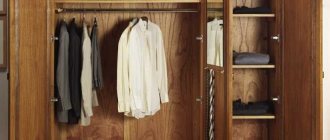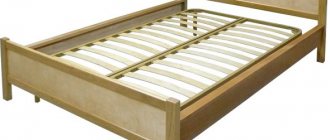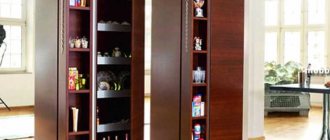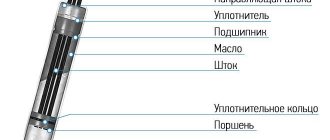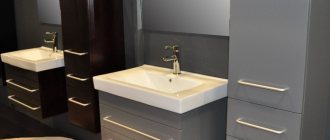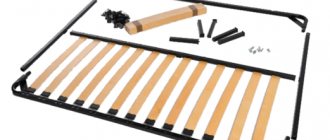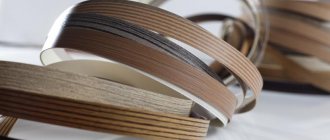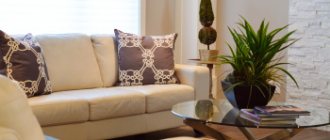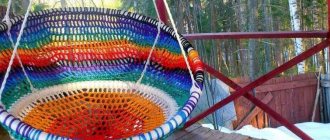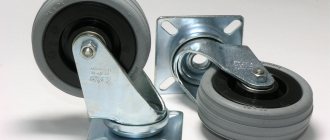51039
Today, furniture edges serve as protection for the end parts of cabinet products. It is offered by most manufacturers, and is also divided into several types. Depending on the purpose of the furniture, a certain type is used, which effectively protects the edges from damage. In order to know which edging to give preference to when choosing products, it is necessary to study their variety, scope of application, as well as sizes.
Scope of use
Regardless of what type of edge is used, it is designed to protect the end parts of the product. Such a device is especially necessary when producing inexpensive furniture from chipboard or laminated chipboard. Since these materials contain harmful formaldehydes, which over time can evaporate their substances into the atmosphere. Edge materials allow you to cover raw edges, preventing the spread of fumes.
Another undoubted advantage of such a detail is the protection of wood materials from moisture getting inside. As you know, water penetrating into the pores of wood has a detrimental effect on it. If solid wood furniture is considered more resistant to moisture, then chipboard definitely needs an edge for the furniture.
Independent production of furniture parts implies the mandatory use of edging. If this is not done, then during operation the uncovered edges of the product will be subject to rapid wear. Possible causes include accidentally touching the edge, scratching with a sharp object, or carelessly closing the doors. This is why processing chipboard with edge material is so important in furniture production. To consolidate the information provided, it is necessary to highlight a number of functions performed by the edge - a special tape made from various raw materials for processing the edges of furniture:
- Beautiful appearance of the ends of the products. When shopping in a store, the buyer first of all looks at the aesthetic design. It is unlikely that he will want to install a sliding wardrobe where the internal shelves look unfinished, and their edges differ in color and structure from the facades;
- Protection from mechanical damage. Edge materials are designed to protect fragile chipboards from moisture and delamination. Chips and burrs caused by impacts can cause snags on clothing and scratches on the skin. The laminated surface of furniture can crack even when in contact with a hard object. If the edges of the parts are sealed with edging, the degree of damage and the chances of loss of attractiveness of the models are minimal;
- Protecting human health. As already mentioned, the edge plays an important role in maintaining the health of household members. The longer the furniture is used, the higher the risk of formaldehyde resins escaping from the chipboard.
When choosing products for your home, you should pay attention to these subtleties. They will help maintain the attractiveness of the furniture and extend its safe use.
Kinds
In modern furniture production, manufacturers offer several edging options. This is convenient for increasing or decreasing the cost of custom-made furniture. In addition, when making products yourself, the question arises of what type of furniture edge to choose. In order not to get confused, it is necessary to understand in detail the features of each, highlighting their pros and cons.
| Name | Description | Advantages | Flaws |
| Melamine | Sold in reels, attached only with glue. The edging tape can be single-layer or double-layer, and is made on the basis of paper. | There is a large selection of colors, the material easily follows the contours of the furniture, no additional equipment is required for the work - everything can be glued yourself. Melamine furniture edging is affordable. | Lack of protection against moisture, has a weak level of protection against mechanical damage. |
| PVC | Made from polyvinyl chloride. Available in two thicknesses, which are used for different parts of the furniture. The cost of the material is slightly more than its melamine counterpart. | The edge will provide protection from acids, alkalis and moisture. The assortment is represented by a rich color variety. PVC edges have a high level of protection against mechanical damage and are also considered durable. Another undoubted advantage is the non-flammability of raw materials. | The film is too rigid, which will not allow for quality processing of the product’s curves. In addition, it can only be fixed using a special machine. Self-attachment is excluded. |
| ABS | Manufacturing material: acrylonitrile butadiene styrene. This type is considered the most resistant to all types of damage. | The most durable edge of all presented. It does not contain chlorine, which is safe for human health. The ABS edge has a fade-resistant finish. It is soft and easy to cut, and does not emit toxic substances. | No significant disadvantages were found for this type of edge. The only thing that can stop you from choosing is the high cost, due to which the price of furniture will increase. However, this disadvantage is compensated by durability. |
| U-shaped from an overlay profile | The use of U-shaped furniture edges is used on products that are constantly exposed to moisture. | The special shape more reliably protects the ends from mechanical damage. The material can be fixed independently using glue. Additionally, it allows you to hide existing defects in the edges of furniture. Prevents any objects from sliding off the shelves or table. | Such framing is considered bulky and does not always look appropriate on furniture. |
Based on the information provided, we can conclude that ABS furniture edging is considered the most optimal for home use - it reliably protects the edges of products, preventing damage.
PVC
U-shaped
ABS
Melamine
Dimensions
To make edging on a countertop or cabinet look natural and attractive, it is best to have this process performed by professionals. Before choosing ready-made furniture or submitting your own products for edging, you need to not only decide on the type of edging, but also decide which size will be most suitable.
For each type of internal filling, it is necessary to use a different thickness of edge. So, for visible ends it is better to use a more reliable option.
Furniture edges are available in the following sizes:
- Paper or melamine edge - the thickness options for such a device are 0.2 or 0.4 cm. Manufacturers see no point in making it thicker, otherwise it will look ugly on the furniture. Self-adhesive furniture edges deserve special attention. Such devices are sold by the meter, as well as in reels of 200 m. Width - 26 mm;
- PVC – product thickness 0.4, 1 and 2 mm. Manufacturers often equip the front ends with thin options, and shelves and drawers with thick ones. The standard width is 26.5 mm, and reels are available in 150, 200 and 300 m;
- ABS - the width of such an edge is from 19 to 22 mm. Thickness can be 0.4, 1, 2 and 3 mm. For reliability, it is recommended to treat the edges with the strongest edging of 3 mm;
- Overlay U-shaped profile - available in widths of 16 or 18 mm for chipboard materials, thickness from 3 mm and above.
Before processing furniture, do not forget to measure the thickness of the material - for chipboard it is 16 mm, for countertops it will be 32 mm. Don’t forget that the main enemies of chipboard are fungus, mold and bacteria, so high-quality edging is considered a mandatory step.
PVC sizes
Melamine Edge Sizes
Edge accent
Any manufacturer knows how important the correct choice of edge material is. The modern market places increasingly high demands on the quality of furniture produced. The end consumer is no longer satisfied with just inexpensive standard furniture; he is interested in appearance, functionality, and the ability of furniture to maintain its original appearance for a long time. The edge must meet all these requirements and serve not only for protection, but also for the design of surfaces, becoming an important design element. At the moment, paper-based edges are most widely used on the Russian market - melamine edges and edges made of PVC and ABS plastics, and melamine edges are gradually losing their positions, losing an increasing share of the market to plastic. The main differences between thermoplastic edges and melamine edges:
- best optical properties
- elasticity
- wear resistance
- resistance to mechanical and shock loads
- waterproof
- high resistance to heat
- recyclability
The history of polymer edging materials goes back more than half a century.
50s:
- predominantly the use of duroplasts (melamine);
- first production of thermoplastic edges;
- material: PVC (polyvinyl chloride) only.
80s:
- The use of PVC in many countries is questionable due to the requirements of environmental organizations. Development of an alternative edge material based on ABS (acrylonitrile butadiene styrene).
90s:
- the beginning of the development of edges with increased resistance to chemicals - PP (polypropylene)
- 1996 The first edge is made of PP.
Nowadays:
- appearance of acrylic edges.
Let's look at the main features of the most common types of plastic edges using the example of some of the world's leading edge manufacturers, Proadec (Portugal) and Giplast Group (Italy).
Features of PVC edges (PolyVinyl Chloride)
- High physical and chemical resistance (protection against abrasion and corrosion)
- Due to its high flexibility it is suitable for small radii
- High resistance to ultraviolet radiation
- Retains its physical properties at temperatures from -50 to + 80°C
- Long service life (more than 50 years)
- Heat shrinkage less than 0.3%
- When burning, no flame is formed
Features of ABS edge (Acrylonitrile Butadiene Styrene)
- Eco-friendly material, as it does not contain heavy metals and chlorine
- Resistant to high temperatures, including 0.45 mm edges
- In addition to standard PVC glue, you can use more resistant types of glue with a higher application temperature
- Available also in super glossy decors
- Retains its physical properties at temperatures from -50 to + 80°C
- Long service life (more than 50 years)
- Heat shrinkage less than 0.3%
- When burning, a flame is formed
- Does not electrify (does not stick to machines)
All edges are produced in various thicknesses - from 0.4 to 5 mm, widths - up to 400 mm, as well as in thousands of decor options. Globally, ABS edgeband dominates in Germany, Austria, Scandinavia and the Netherlands. PVC is still dominant in Belgium, France, Greece, Poland and the Czech Republic, and dominates in Spain and Portugal. There are many varieties of PVC and ABS edges designed for use in each specific application.
| Standard thin edge A thin edge connected to a continuous base, which gives it softness and a more harmonious appearance of the furniture as a whole. |
| Thick two-tone edge An edge with a special decoration of two solid colors or a solid color combined with a wood-like one, creating a contrasting effect that enhances the color of the coating. |
| Thick tri-color edge An edge with a decor of three solid colors combined with a tree-like finish. |
| Highly flexible PVC edge Highly flexible edges are developed specifically for small radius bends, ideal for use in contour edges. |
| Bright colors of PVC edges Bright colors throughout the entire thickness of the PVC edge. The edge is specially designed to add brightness to the furniture. |
| Thick edge with two grooves An edge with excellent protection against physical impact and an unusual design. The pitch of the grooves increases in proportion to the width of the edge. |
| Thick edge with multiple indentations An edge with a unique design and unusual color effects. Grooves with a constant pitch, regardless of the width of the edge. The number of grooves is proportional to the width of the edge (edge thickness 22 mm - 5 grooves). The color of the grooves on one edge may vary. |
| An edge with a lot of small grooves. An edge with a lot of small, shallow grooves. It is also produced in wood-like decors. |
| Marble edging A new range of edging materials imitating beautiful marble decors. |
| Paintable edge with primer for subsequent coloring after application. |
| Thermo Chromic edge The edge changes color depending on the ambient temperature. |
Following modern trends in the furniture market, it is necessary to mention new types of edges. These are acrylic edges and super glossy ABS edges. Transparent edges
from
Probos (Proadec)
are made of transparent acrylic (PMMA-polymethyl methacrylate). The decor is applied to the inner surface of the edge material and is protected on top by a layer of transparent polymer, which prevents it from damage and abrasion. When cutting off the overhangs, only the transparent layer of plastic is removed, so there is no frame effect, creating a feeling of solidity of the slab and the visual effect of a three-dimensional image.
Glossy colors are becoming increasingly popular in modern furniture. Facades, countertops, as well as many other elements of kitchen and children's furniture are increasingly made in gloss. When working with glossy surfaces, you cannot do without appropriate edges. Extraglossy edge
by
Giplast Group
is made from ABS and has a maximum degree of gloss (100 GU), which is achieved through the use of a special varnish coating in the production of the edge. On the Russian market, MDM is one of the leading companies supplying furniture fittings and edgebanding materials. In this variety of edges, any manufacturer will find the right solution for cladding slabs. At the moment, the MDM warehouse program includes paper-based edges - melamine edges, and edges made of PVC and ABS plastics, including shock-absorbing edges, and a large selection of flexible mortise and overlay profiles of various shapes and decors. All edges are available in a variety of colors, embossing, widths and thicknesses.
Now all the company's efforts are aimed at optimizing the warehouse program of edge materials in order to create an offer that meets the requirements of most furniture makers. This summer the range of sizes offered for PVC and ABS edges has been significantly expanded. Now any decor available in the MDM warehouse program, which includes more than 80 different colors, is presented in a wider range of sizes. Available in thicknesses 0.45, 1 and 2 mm, widths 19, 22, 26, 29, 32 and 36 mm. In the near future, the assortment will be replenished with 14 new decors. Naturally, when choosing new colors, the company was guided by popular decors of laminated boards. For the convenience of customers, tables have been developed for matching edges with laminated chipboard decors prevailing on the Russian market. In the company's catalog you can find suitable edges for both slabs from leading European manufacturers and slabs from most Russian factories. With the introduction of new products, the warehouse program of MDM edging materials will include about 100 different decors, among which you will certainly find the color you need.
Criterias of choice
Furniture edging significantly improves the appearance of cabinets, drawers, tables, and any other cabinet furniture. Today it is available in various colors, and choosing an option to match the shade of the furniture will not be difficult. To make the selection process easier, and the result to please the family for many years, pay attention to the following selection criteria:
- Material – speaking of material, edgings can be divided into paper, plastic and rubber. The pros and cons of each of them have been described above. When choosing, you should pay attention to its compatibility with the material of production of the furniture itself;
- Width - popular sizes vary between 22 and 38 mm, so before edging the product, it is worth choosing the optimal width - it should completely hide the edges of the product;
- Thickness – today manufacturers use edges from 0.2 mm thick. It is necessary to take into account the purpose and storage conditions of the furniture in order to select the required thickness parameter;
- Presence of an adhesive layer. This criterion is important for people who want to secure the edge to the product themselves. If the device does not have an adhesive layer, then you will not be able to make the edging yourself;
- Type of fastening - there are rigid, overhead and mortise edges. Depending on the purpose, choose one of the options. The mortise type is also divided into T-shaped and U-shaped;
- Surface type - edge coating can be glossy, matte, embossed or embossed. Take this criterion into account to improve the appearance of the furniture.
Having studied all the indicators of furniture edges, you can safely go for a new set of furniture. When purchasing, pay special attention to the quality of processing of the edges and end parts. It is worth additionally asking the seller about the method of fixing the edge. By purchasing furniture products with durable edges, you can ensure they have a long service life.
Disadvantages of using melamine edging
Despite the large number of advantages, it is worth considering a number of possible negative aspects of using melamine edges. First of all, she should not finish products that are often in contact with a humid environment, are exposed to temperature changes, etc. All these factors will shorten the service life of the finish, and therefore the furniture itself.
Additionally, although the edge is attached without the use of special equipment, it should only be applied by professionals. Otherwise, the practical and aesthetic properties of the material will be significantly reduced.
Modern production of furniture products practically cannot do without the use of melamine edges. The range of its applications is quite large, the range is huge, and the cost of the material is low.
